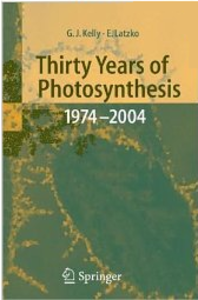Photosynthesis. carbon metabolism: new regulators of CO2 fixation, the new importance of pyrophosphate, and the old problem of oxygen involvement revisited
Kelly, Grahame J., Holtum, Joseph A.M. , and Latzko, Erwin (2006) Photosynthesis. carbon metabolism: new regulators of CO2 fixation, the new importance of pyrophosphate, and the old problem of oxygen involvement revisited. In: Kelly, G.J., and Latzko, E., (eds.) Thirty Years of Photosynthesis: 1974-2004. Springer, Berlin, Germany, pp. 157-184.
|
PDF (Published version)
Restricted to Repository staff only |
||
![[img]](https://researchonline.jcu.edu.au/1140/2.hassmallThumbnailVersion/1140_Kelly_et_al_2006.jpg)
|
Image (JPEG) (Cover Image)
- Cover Image
Download (128kB) |
Abstract
Since writing our last review in Volume 50 of Progress in Botany, a rather remarkable event has taken place. Photosynthetic carbon metabolism has become a public issue. People have become aware of the fact that the atmospheric CO2 level is increasing "rapidly" (ca. 0.4% per year, and that this additional CO2 will, theoretically, absorb additional outgoing infrared radiation, thereby warming the earth - the hypothesized "greenhouse effect". Given that additional atmospheric CO2 will also, theoretically, stimulate photosynthetic CO2 fIxation, the reason for renewed public interest in photosynthesis becomes clear. It is quite another matter, however, to gather together what is known of photosynthesis and to predict, with a good degree of certainty, the extent to which the theoretical CO2-stimulation of photosynthesis will actually take place. With good luck or with good counsel (we know not which), current emphasis in research on photosynthetic carbon metabolism is presently on the uptake of CO2 by photosynthetic cells, and on the fixation of this CO2 by ribulose-l,5-bisphosphate (RuBP) carboxylase and, in the case of C4 plants and crassulacean acid metabolism (CAM) plants, by phosphoenolpyruvate (PEP) carboxylase. The results of this research are definitely assisting our efforts at prediction, as described below. It will also be important to have available the result of studies on the capacities of plant carbon sinks, both temporary (transitory starch, sucrose for translocation), and permanent (roots, fruits, seeds, and especially wood). Finally, the ability of plants to continue photosynthesis under adverse conditions, as may eventuate from future climate changes, may be ascertained from investigations of photosynthesis under stress conditions, and the parts played by photorespiration, CAM and other mechanisms in delaying the Qnset of the photo inhibition that ensues when there is nowhere safe for the light-generated reductant to go. This review covers the research on these topics reported over the past 2 years, and concludes with some brief thoughts on the capacity of global photosynthetic CO2 fixation to counter the predicted CO2-induced global "greenhouse" warming.
| Item ID: | 1140 |
|---|---|
| Item Type: | Book Chapter (Research - B1) |
| ISBN: | 978-3-540-28382-9 |
| Keywords: | photosynthesis, carbon metabolism |
| Date Deposited: | 08 Nov 2006 |
| FoR Codes: | 06 BIOLOGICAL SCIENCES > 0607 Plant Biology > 060705 Plant Physiology @ 100% |
| SEO Codes: | 97 EXPANDING KNOWLEDGE > 970106 Expanding Knowledge in the Biological Sciences @ 100% |
| Downloads: |
Total: 207 Last 12 Months: 4 |
| More Statistics |



